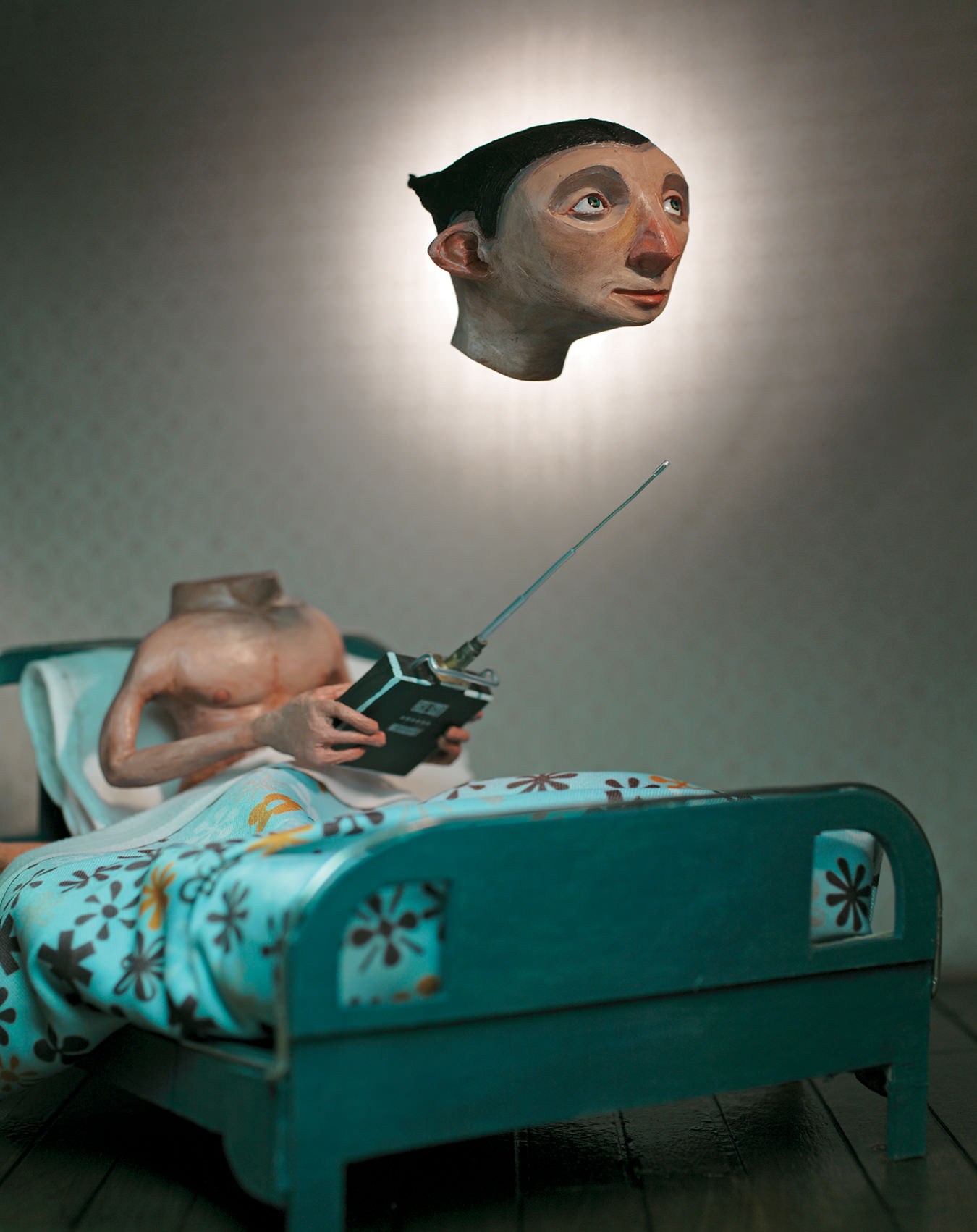Lucid Dreaming
Altered state.

Most people don’t pay much attention to dreams. If they’re even remembered—and often they are forgotten—they affect our lives minimally. And it’s no wonder, really; dreams are filled with absurdities and situations that range from the fun and entertaining (winning the lottery and flying seem to be pretty common) to the uncomfortable and downright scary (dreaming that you’re about to give a speech and suddenly you realize you’re unprepared). Nobody knows for sure what causes dreams—whether they’re just the mind’s way of decompressing at the end of a day full of stimulation, or some kind of mental screensaver, or even something more spiritual and meaningful. As far as we know, they aren’t tangibly useful. Could there be a use for dreams?
Despite the surreal and impossible events that we experience, we don’t often realize that we are in a dream, at least at the time. Sometimes it does happen, often just as we are waking up, that odd, intangible feeling that this reality isn’t exactly real, and then the almost breathtaking realization: I’m dreaming. This is usually fleeting, however; when you come up from the depths of sleep, you awaken feeling perplexed, with the faint echo of some important realization that you can’t quite grasp. But what if…
What if you could prolong this awareness and, for example, check out your dream surroundings? Examine in detail the dream environment in which you are standing, or bolder still, alter or manipulate that environment? You could do anything—the dream landscape would be your sandbox to create and experience anything you wanted.
While it sounds like the stuff of science fiction, lucid dreaming, as it’s known, is in fact a scientifically proven phenomenon; the term was coined around the beginning of the 20th century by Dutch psychiatrist and lucid dreamer Frederik van Eeden, and there are recorded experiences reaching as far back as Aristotle. Whereas in a typical dream we perceive all happenings to be reality, in a lucid dream we are, to some extent, aware that what we see, hear and feel is not actually happening, allowing for some agency in how it all unfolds.
“I like to define it as cognizant dreaming—literally having knowledge of what it is you’re doing while you’re doing it,” says Dr. Stephen LaBerge, a world-renowned Stanford University psychophysiologist and an authority on lucid dreaming. “I’ve spelled it out to myself: this is a dream.” An epic lucid dreamer since childhood, Dr. LaBerge came to pursue the phenomenon professionally through coupling the mind-expanding, Eastern philosophies–spiked experience of living in the San Francisco Bay Area in the sixties with his scientific interest in the brain. Later, as part of his dissertation at Stanford, Dr. LaBerge defied the scientific community by proving that wakefulness and the dream state are not, as was commonly held, mutually exclusive.
“Once you know you’re dreaming, you are restricted only by your ability to imagine and conceive, not by laws of physics or society.”
The experiment Dr. LaBerge devised to prove that one can attain wakeful-like consciousness while in a dream state was surprisingly simple. The eyes and ocular muscles are not affected by sleep paralysis, and thus move around, specifically during the period of “rapid eye movement”, or REM sleep. As well, research has indicated that a dreamer’s eye movements while in REM sleep can actually correspond to the direction in which a person is “looking” in a dream. Dr. LaBerge theorized that if he could attain lucidity and recognize that he was dreaming, he would be able to act at will and would deliberately move his eyes back and forth, left to right, thus communicating that he was indeed dreaming and quite consciously aware of the fact.
The experiment was a success. Monitored by Dr. Lynn Nagel, then a research associate at Stanford’s sleep lab, Dr. LaBerge slept while hooked up to an electroencephalogram machine, which is used to measure the electrical activity of the brain. During his REM sleep, Dr. Nagel registered distinct instances of left-to-right eye movement; Dr. LaBerge was dreaming, knew it, and conveyed to the outside world that he knew it. And there it was: consciousness and a “waking” awareness, thought to be irretrievably unplugged while dreaming, in actuality is only dormant.
Since Dr. LaBerge first published his groundbreaking results in 1980, many similar experiments have been successfully performed around the world, felling staunch deniers of the phenomenon one by one, and inducting lucid dreaming into the realm of accepted science. Even one of its last tenacious skeptics, Harvard psychiatrist and dream researcher Dr. Allan Hobson, famous for chalking up dreams to nothing more than a series of essentially random blips of the cerebral cortex, has recently—in his own way—conceded that lucid dreaming is a possibility: “In the technical language of psychology, [lucid dreaming] is a dissociation; it’s very elusive, but what you have is components of the waking state entering into the dream state. Lucid dreaming is … REM sleep/waking.”
The ability to direct our dreams sounds like an innovation replete with possibilities, so why hasn’t it been picked up by the mainstream? “Lucid dreaming is a cognizant skill which you have to want to develop,” says Dr. LaBerge, who has authored several books on the subject, including Exploring the World of Lucid Dreaming. “If you ask the average person on the street if they’ve had a lucid dream and would they like to have more, most wouldn’t care about it and think you’re a crazy person. … It all comes down to interest and volition.”
And the truth is, lucidity is very elusive. More often than not, people become aware they’re dreaming spontaneously, typically waking up shortly thereafter or lapsing back into another dream. That is why these days, even though he’s been one of the main scientific forces behind consolidating and furthering dream theory, Dr. LaBerge is more concerned with the how of dreaming than the why. In 1987, he founded the Lucidity Institute, a private organization dedicated to improving people’s ability to experience and enjoy the benefits of lucid dreaming through ongoing research.
The Institute also holds an instructional workshop in Hawaii. Entitled “Dreaming and Awakening: Lucid Dreaming, Conscious-ness and Dream Yoga”, the 10-day retreat has attracted dream enthusiasts from all over the world—people who are “looking for more out of life”, according to Dominick Attisani, one of the retreat’s presenters, who specializes in transitional states of consciousness including hypnogogia (the moments as one is falling asleep), REM onset, and wake-initiated lucid dreams. “It’s dream boot camp—an intensive program giving people techniques on how to produce lucid dreams, and the science behind it. It’s probably the equivalent of a six-credit graduate course, in addition to being training for the prospective dreamer.” Most of the work happens at night, of course, but the workshop’s day schedule revolves around two instructional group sessions: one in the morning, where participants discuss the previous night’s dreams and receive personal direction, and a more structured presentation in the early evening during which Dr. LaBerge expounds on induction techniques, as well as the history of sleep science in the context of lucid dreaming. Aside from reiterating motivation and effort, Dr. LaBerge guides attendees through the following lucidity-inciting techniques:
Dream Recall: The first and most important step is to remember your dreams. This allows you to familiarize yourself with their features and patterns, helping you to recognize a dream while it’s happening. To increase dream recall, Dr. LaBerge suggests getting lots of sleep, keeping a dream journal, setting the alarm for the middle of the night in order to harvest a fresh dream memory, and reminding yourself before falling asleep that you must try to remember all you can upon waking.
Reality Testing: As illustrated in Richard Linklater’s film Waking Life, words and numbers (particularly those on digital clocks) act strangely in dreams, changing as you look at them and even morphing into unreadable characters. A habit of checking the time frequently throughout the day can carry over to your dreams, thus helping you determine if you are dreaming.
Dream signs: Recurring and often strange or bizarre events such as miraculous flight or the feeling of being chased are a sure way to recognize when you’re dreaming.
Mnemonic Induction: A technique developed by Dr. LaBerge that involves telling yourself over and over to remember to do something in the future, like remembering your dreams and remembering to look for dream signs the next time you’re dreaming.
Napping: Practice makes perfect.
As a regular habit, lucid dreaming may seem a bit too New Agey for some people—and although people from all walks of life attend the retreat, Dr. LaBerge does concede that it helps to have “cognitive flexibility and creativity”, that is, the ability to see the usual as unusual and the unusual as usual. “The temperament types that we find at our dream program are all intuitive types,” he says. “Out of 25 [participants], we’ll have 10 who are intuitive thinkers—Promethean or Apollonian scientist types—and 15 who are intuitive feelers—artistic, into transcendental, New Age experiences. Two-thirds of the general population are of the ‘guardian’ temperament, happy not to question their reality, and if we ever get one of these types, it’s always the same: they’re there with a spouse.”
Toko-pa Turner, a past participant, says that for her, attending the retreat was a pivotal experience. “The program showed me that interest would be there should I pursue dreamwork as a vocation.” Now a dream interpreter with a “dream school” in Nelson, B.C., she cautions against the possible uses of lucid dreaming: “Because of how powerful lucid dreaming is, my intuition was to approach it with a slow reverence. I don’t believe in perpetuating fear about it, but if dreams are treated too much like a video game, for lucid sex and acrobatics, it can become similarly addictive and anti-social.”
It is true that flying and fulfillment of sexual fantasies are the two most common pursuits of a neophyte, but one of the Lucidity Institute’s raisons d’être is to promote the idea that lucid dreaming has tremendous possibilities for self-improvement, healing and even fostering spirituality. (Despite being a scientist, Dr. LaBerge describes having god-like transcendental experiences in his lucid dreams, as powerful as a yogi’s.)
According to Dr. LaBerge, “The overwhelming majority of lucid dreams are positive, rewarding experiences,” and it can be an effective basis for all kinds of therapy. By becoming proficient at realizing when you’re dreaming, you can begin to act at will. The sky is no longer the limit; you can dispel and eliminate nightmares, practise skills such as public speaking, rehearse dance routines, and enhance all manner of problem-solving abilities. “Once you know you are dreaming, you are restricted only by your ability to imagine and conceive, not by laws of physics or society,” he says. Having worked in the scientific study of lucid dreaming for nearly 30 years, Dr. LaBerge has enlightened us about what is perhaps the most palatable way since the days of Freud and Jung to explore one of the last remaining frontiers of humankind: dreamland.




